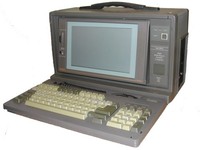Dolch 286-Pack Portable Computer
| Home > Browse Our Collection > Computers > Dolch Computer Systems > Dolch 286-Pack Portable Computer |
|
Dolch 286-Pack portable computer (Model No. DP286-12) with carrying case. This was originally used to develop a portable E-FIT system for the British Police.
Below is a Short History of E-FIT and the role that our Dolch 286 played in the development: E-FIT (Electronic Facial Identification Technique) was developed by the Police Research and Development Branch (P.S.R.D.B.) of the Home Office in collaboration with a number of outside agencies. In April 1970, the Home Office launched Photo-FIT, which had been developed by Jacque Penry for use by police to obtain facial likenesses of a suspect from an eyewitness. During the 1970s the legal system concerning the accuracy of eyewitness identification was challenged by academic research, especially that of the Department of Psychology at Aberdeen University. As a result the Home Office contracted Aberdeen to continue specific research and make recommendations. One area of their research led to the creation of E-FIT in collaboration of the Computer Aided Design Centre at Cambridge. By 1976 they had demonstrated the viability of a computerised composite system which was based on a Sperry 2000 main frame machine. The tests of the system showed that it was marginally better than the manual Photo-FIT system. The Home Office appreciated that Chief Constables would be reluctant to spend the money necessary to purchase a Sperry machine for so little benefits, and the program was shelved. The Police Service continued to use Photo-FIT, but by the mid 1980s it was apparent that it need a radical overhaul and updating. Such was the agitation of two officers in particular ( DI Robert Ashcroft of Warwickshire Constabulary, and DS Peter Bennett of the Metropolitan Police), that in April 1985 the Home Office set up a working party to look at the issues, and instituted a training programme to ensure that all Photo-FIT operators had the necessary skills to use it effectively. P.S.R.D.B. was also sanctioned to look at the E-FIT system with a view of creating a program that would run on the smaller Microsoft DOS work stations. A trial system was developed by 1987. The system relied upon the eye witness being able to describe and recognise seven facial components, namely, hair, face shape, eyebrows, eyes, nose, mouth and ears. Although the program could manipulate each of these features, it lacked the ability to ‘fine tune’ features ‘artistically’. Research by Bennett had already established that this was a necessary feature of any composite system seeking to recreate an accurate facial likeness.
Io Research was a company that had developed graphic art packages that would work on Microsoft Systems and in 1987 were contracted by the Home Office to assist develop E-FIT so that it was integrated with the Pluto graphics board and programme. A spin-off of this collaboration was that a program was developed using the Pluto to create databases of the facial features used by E-FIT. Although the Pluto Graphics program was eventually replaced by ‘paint programs’ such as Aldus PhotoStyler , Micrographics Picture Publisher and Adobe PhotoShop, the Pluto system was used to create and update the E-FIT image databases until 2002. Io Research was given a licence by the Home Office to sell E-FIT systems. In time Io Research was wound up and the company became known as E.G. (Electronic Graphics), which in turn became known as Aspley Ltd. The first E-FIT system was sold to Hertfordshire Constabulary in 1989, and in time the term E-FIT became synonymous with any facial image produced by an eyewitness. As stated above the E-FIT program was developed to run on Microsoft DOS based work stations. As a result eye-witnesses had to come to the police premise which housed the system. Clearly there were many occasions when this was not possible, for example the witness was in hospital after an assault, or was elderly and confined to his/her home. To overcome this problem, the Home Office purchased a Dolch 286 portable PC, and Io research developed a graphics card, that had the same functionality as the Pluto system. We believe that the Dolch that we now have is the one given to Io Research for that initial development. In 2007, Aspley Ltd was purchased by VisionMetric Ltd. This is a start-up company based at the University of Kent, whose Physics Department have developed the next generation of Facial Composite systems which they market as E-FITv. Manufacturer: Dolch Comment on This Page Other Systems Related To Dolch 286-Pack Portable Computer:
This exhibit has a reference ID of CH1176. Please quote this reference ID in any communication with the Centre for Computing History. |
|













